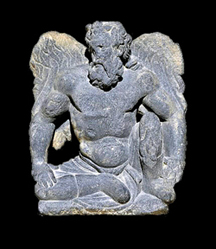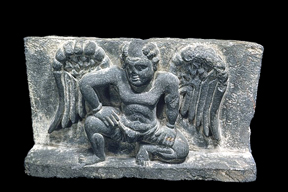
From Gandhara, Pakistan
2nd-3rd century CE
Grey schist
Height: 22.9 cm
Acquisition number: #OA 1880-182
Image courtesy of the British Museum (copyright reserved).

From Gandhara, Pakistan
2nd-3rd century CE
Grey schist
13.02 x 22.54 cm
Acquisition number: #57.106
Eugene Fuller Memorial Collection
Image courtesy of the Seattle Art Museum (copyright reserved)
These two winged relief figures, both originally created for an architectural context, are a reminder of the Hellenistic influence that lingered in Central Asia long after Alexander's demise. The territory stretching east from the Caspian Sea to the Hindu Kush Mountains and southeast to the Indus River Valley came under the control of the Greeks during Alexander's campaign in the late fourth century BCE. Part of this area became the kingdom of the Seleucids, while regions further east, including Bactria and Sogdiana, were controlled by Greek noble families ruling the territories as independent kingships. Though the Seleucids would eventually be annexed by Rome in the 1st century CE, the smaller kingdoms remained independent until the Sassanian Empire absorbed the region sometime in the mid-3rd century.
The Greek rulers of these kingdoms retained their Hellenistic heritage; particularly after Greece became part of the Roman Empire, they deeply felt a responsibility to keep Greek language, culture and traditions alive by Hellenizing Central Asia. For this reason, local art and architecture was largely based on classical Greek models, though indigenous elements were also expressed. These two winged figures, both seated or crouched in similar poses, would have decorated the interior of a stone building; they were placed along the ceiling line, perhaps at the top of a support column, to appear as if they were supporting the roof. They are commonly called "atlas figures," in reference to the Greek mythological legend of the Titan Atlas, who supported the heavens on his shoulders.